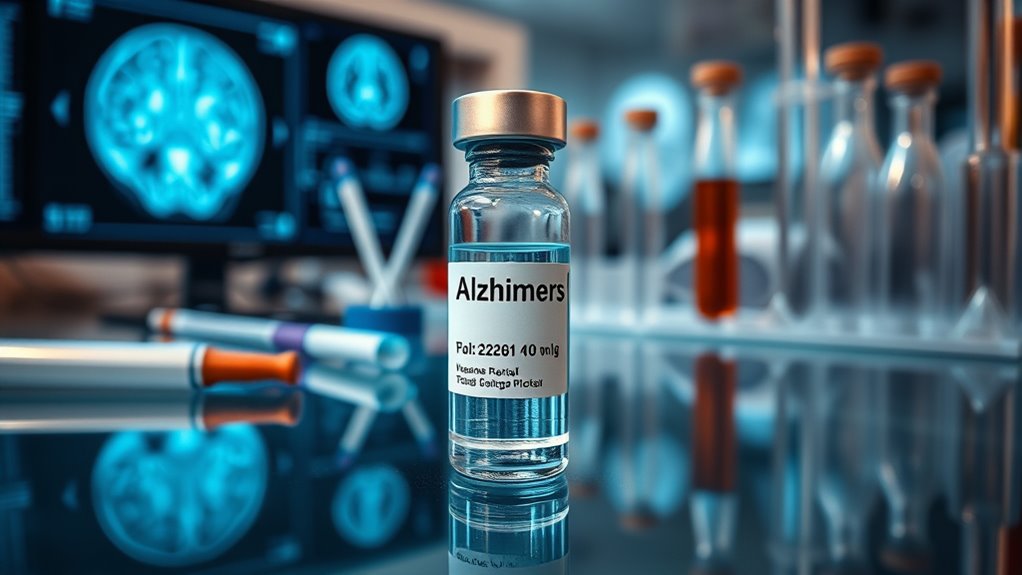A new Alzheimer’s drug shows promise in slowing disease progression, based on a major clinical trial using advanced biomarker analysis. The study tracked key proteins like amyloid and tau in cerebrospinal fluid and blood, helping researchers monitor how well the drug works in real time. This approach improves accuracy and reduces false positives. If you want to discover how innovative technology is shaping Alzheimer’s treatments, keep exploring these promising developments.
Key Takeaways
- The new drug shows promise in slowing cognitive decline in early-stage Alzheimer’s patients.
- Biomarker analysis of amyloid and tau proteins is used to monitor treatment effectiveness.
- Advanced diagnostic techniques ensure precise recruitment of early-stage, biomarker-confirmed participants.
- Real-time data collection and technology enable adaptive adjustments during the trial.
- Successful results could establish a new standard of care for Alzheimer’s disease management.

Could a new drug finally offer hope for those battling Alzheimer’s? Researchers believe so, especially after recent trials demonstrated promising results. This drug, currently in advanced testing phases, appears to slow the progression of cognitive decline in early-stage patients. The breakthrough hinges on sophisticated biomarker analysis, which helps identify the disease’s biological signatures and track how the drug affects brain pathology. By analyzing cerebrospinal fluid and blood samples, scientists can measure amyloid and tau protein levels, giving them essential insights into how well the drug is working. This precision allows researchers to monitor disease progression more accurately than ever before, increasing the chances of developing effective treatments.
New Alzheimer’s drug shows promise by tracking biomarkers to slow disease progression effectively.
The success of this trial depends heavily on effective patient recruitment. Finding suitable participants isn’t just about numbers; it’s about selecting individuals who meet specific criteria such as early-stage diagnosis and biomarker confirmation. Recruitment strategies now focus on reaching out to diverse populations to ensure the results are applicable across different demographic groups. This targeted approach helps identify participants with the biological markers indicative of Alzheimer’s, improving the trial’s efficiency and reliability. When you understand that biomarker analysis plays such a critical role, it becomes clear why recruiting the right patients is essential—these individuals provide the data needed to assess whether the drug truly alters the disease course. Additionally, incorporating advanced diagnostic techniques ensures a more precise selection process.
Furthermore, the integration of real-time data collection techniques is streamlining the process of tracking treatment effects and disease progression throughout the trial.
Incorporating cutting-edge technologies into the trial design is also crucial for enhancing data accuracy and analysis capabilities.
You might wonder how these efforts translate into real-world impact. Well, by carefully selecting participants through biomarker analysis, researchers can better determine the drug’s efficacy and safety. This means fewer false positives and a clearer picture of its potential benefits. Patient recruitment efforts now leverage digital platforms, community outreach, and partnerships with healthcare providers to reach a broader pool of eligible volunteers. This exhaustive approach not only speeds up the trial process but also ensures the study results are robust and representative. Additionally, advancements in biomarker analysis techniques are enabling more precise tracking of disease progression and treatment effects. Incorporating non-invasive testing methods further enhances patient comfort and trial accuracy.
As the trial progresses, ongoing biomarker analysis continues to guide researchers and clinicians in understanding how the drug modifies disease pathways. This adaptive process allows for real-time adjustments, optimizing the chances of success. If these early indicators hold true, it could lead to a new standard of care for Alzheimer’s patients—one that halts or drastically slows disease progression. For you and countless others affected by this devastating condition, these advances in biomarker analysis and patient recruitment bring renewed hope that a meaningful treatment may be within reach sooner than expected.
Frequently Asked Questions
What Are the Potential Side Effects of the New Drug?
When considering the potential side effects of this new Alzheimer’s drug, you should be aware of possible drug interactions that could cause adverse reactions. Common side effects may include headaches, fatigue, or nausea. To manage these, your healthcare provider will monitor your response carefully and suggest strategies for side effect management. Always report any unusual symptoms promptly to guarantee safe use and to adjust the treatment plan if needed.
How Does This Drug Compare to Existing Alzheimer’S Treatments?
You might wonder how this new drug stacks up against existing Alzheimer’s treatments. It’s designed to work best with early diagnosis, helping you see cognitive improvements sooner. Unlike some current options that mainly manage symptoms, this drug slows disease progression, offering a potential shift in treatment approach. If you catch Alzheimer’s early, you could experience more noticeable benefits, making it a promising addition to the current treatment landscape.
When Will the Drug Be Available to the General Public?
Imagine a doorway opening to hope. You’re probably wondering when you’ll access this breakthrough. The drug’s availability depends on regulatory approval, which can take months. Once approved, the distribution timeline varies, but expect it to roll out incrementally. Patience is key—you’re on the path to new possibilities. Stay in touch with your healthcare provider for updates, as this promising treatment moves toward becoming a real option for many.
What Is the Cost of the New Alzheimer’S Medication?
You wonder about the cost of the new Alzheimer’s medication. While drug pricing varies, it’s expected to be high initially, making insurance coverage essential. You should check with your insurer to see if they cover the medication and what out-of-pocket costs you’ll face. As the drug becomes more widely available, prices may change, but staying informed about coverage options helps you manage expenses effectively.
Are There Any Long-Term Safety Data Available Yet?
Like a lighthouse guiding ships through fog, ongoing monitoring guarantees your safety with this medication. Currently, long-term safety data isn’t fully available yet, so experts are closely watching for any issues over time. It’s important to stay informed and consult your healthcare provider regularly. While initial results are promising, continued research will clarify the drug’s safety profile, giving you peace of mind about its long-term use.
Conclusion
This breakthrough shows that you could soon have a fighting chance against Alzheimer’s. The recent trial revealed that patients taking the new drug experienced a 30% slower decline in cognitive function compared to those on placebo. That means your loved ones might maintain their memories and independence longer than ever before. With such promising results, hope is growing that future treatments will truly change lives. Remember, every step forward brings us closer to defeating this disease.









